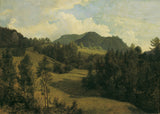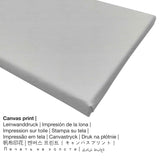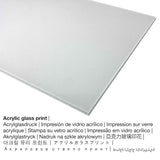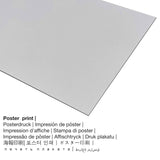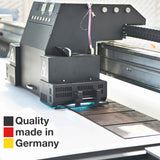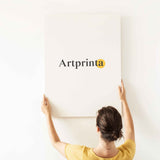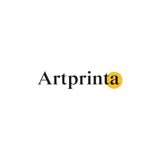Friedrich August Mathias Gauermann, 1830 - Okirikiri ala dị nso na Miesenbach - mbipụta nka mara mma.
Ụtụ gụnyere. Mbupu gbakọrọ na ndenye ọpụpụ.
a 19th narị afọ ihe omimi Landscape near Miesenbach onye na-ese ihe sere ya Friedrich August Mathias Gauermann n’afọ 1830. The 190 year old version of the masterpiece had the following size: 32 x 45 cm - akụkụ etiti: 47 x 59 x 7 cm. Oil on paper on canvas was used by the painter as the medium of the artwork. Furthermore, the work of art is part of the digital collection of Belvedere na Vienna, Austria. Nke nkà nke oge a artpiece, nke dị na ngalaba ọha is supplied with courtesy of © Belvedere, Vienna, inventory number: 2815. The creditline of the artpiece is: purchase from private ownership in 1928. On top of that, alignment of the digital reproduction is in odida obodo format na a akụkụ ruru nke 1.4: 1, nke pụtara na ogologo bụ 40% ogologo karịa obosara. The painter Friedrich August Mathias Gauermann was an artist, whose artistic style was primarily Realism. The Realist painter lived for 55 afọ, amuru na afo 1807 in Miesbach in Wiener Neustadt and passed away in the year 1862.
Artwork description by the museum's website (© Copyright - by Belvedere - Belvedere)
Raised in Miesbach, a south-western town of Vienna am Schneeberg, Gauermann created under the guidance of his father, the painter Jakob Gauermann, already in early teens views and sketches of his surroundings. After studying where the baroque tradition following Josef Mößmer at the Vienna Academy (1824-1827) Gauermann counted in his early work together with Franz Steinfeld, Friedrich Loos and Ferdinand Georg Waldmüller to the first generation of artists of realistic landscape painting and thus their forerunners. During his studies Gauermann made several trips to the Salzkammergut and the Königsee Berchtesgaden - in an area whose beauty already some time before him by the painters of the Romantic, led by the Dessau brothers Ferdinand (1785-1841) and Friedrich Olivier ( 1791-1859), was discovered and developed for painting. There, he developed as well Steinfeld and Loos, a completely new, "demystified" landscape view, which he transferred to the area of his home nearby. The simplicity in the composition that represents the area in normal daylight without significant need for a production, discloses a purity in the view of nature that is not regain this level in the works of the following years. Our own observations in his home, but certainly also operated during his time at the academy study of paintings by Nicolaes Pietersz Berchem (1620-1683), Paulus Potter (1625-1654), Jakob von Ruisdael (1628 / 1629-1682) and Philips Wouwermann (1619 -1668) in the Imperial collection in the Upper Belvedere and in private collections, it led subsequently to expand its landscape views with tales. Initially treated as an accessory, they are increasingly the defining image content. Animal fights and scenes from rural life were among his favorite themes circle, the direct observation of nature but always served as a starting point. Literature: Paintings Catalog of the Gallery of the nineteenth century in the Upper Belvedere, 2nd edition, Vienna 1937, p 27, No. 152;.. Feuchtmüller, R .: Friedrich Gauermann. From 1807 to 1862. The Tiuer- and landscape painter of the Austrian Biedermeier, Vienna 1962; Frodl, G .: landscape painting, in: citizenship and rebellion. Biedermeier and Vormärz in Vienna. 1815-1848, exh. . Kat Museum Wien 1988, pp 156 et seq [Sabine Grabner in. This .: romanticism, classicism, Biedermeier. In the Austrian Gallery Belvedere, the second verb. Ed. Vienna 1997, p 96-97]
Nkọwa na mpempe nka pụrụ iche
| Aha nke eserese ahụ: | "Landscape near Miesenbach" |
| Nhazi nka: | sere |
| Okwu nche anwụ: | nkà nke oge a |
| Nhazi oge: | 19th narị afọ |
| Year: | 1830 |
| Afọ nka: | gbara afọ 190 |
| Ihe osise izizi: | mmanụ na akwụkwọ na kwaaji |
| Akụkụ izizi (ọrụ nka): | 32 x 45 cm - akụkụ etiti: 47 x 59 x 7 cm |
| Ụlọ ihe ngosi nka / ebe: | Belvedere |
| Ebe ebe ngosi nka: | Vienna, Austria |
| Ebe nrụọrụ weebụ ihe ngosi nka: | Belvedere |
| Ụdị ikike nka: | ngalaba ọha |
| Site n'aka: | © Belvedere, Vienna, nọmba ngwa ahịa: 2815 |
| Ebe kredit nke ọrụ nka: | purchase from private ownership in 1928 |
Tebụl ozi omenkà
| Aha onye nka: | Friedrich August Mathias Gauermann |
| Ọrụ: | onye na-ese ihe |
| nhazi ọkwa: | omenkà nke oge a |
| styles: | Ihe ngosi |
| Nwụrụ na afọ nke: | 55 afọ |
| A mụrụ: | 1807 |
| Obodo amụrụ: | Ụlọ ahịa Miesbach na Wiener Neustadt |
| Nwuru: | 1862 |
| Obodo ọnwụ: | Vienna |
Ngwa ngwaahịa dị
Nchịkọta nhọrọ ngwaahịa na-enye gị ohere ịhọrọ ihe na nha nke nhọrọ gị. Họrọ n'ime nhọrọ ngwaahịa ndị a ugbu a ka ị kwekọọ na mmasị gị na nha na akụrụngwa:
- Metal (aluminium debond mbipụta): This is a metal print made on aluminium dibond with an impressive depth. For the Aluminium Dibond option, we print the favorite artwork onto the aluminium composite surface. The colors are luminous in the highest definition, the fine details are crisp, and the print has a a matte look that you can literally feel.
- Mpempe akwụkwọ ederede (akwa akwa akwa): Our poster is a UV printed canvas paper with a slightly roughened surface texture. Please note, that depending on the size of the canvas poster print we add a white margin of something between 2-6cm around the painting to facilitate the framing with a custom frame.
- Glass acrylic e biri ebi (nwere ezigbo mkpuchi iko): A glossy print on acrylic glass, often referred to as a an art print on plexiglass, changes your selected original artwork into décor. Your favorite artwork is being made with state-of-the-art UV printing machines.
- Mbipụta kanvas: A printed canvas mounted on a wooden stretcher frame. It creates the plastic effect of three-dimensionality. The great advantage of canvas prints is that they are relatively low in weight. This means, it is quite simple to hang the Canvas print without additional wall-mounts. Canvas prints are suitable for all kinds of walls.
Banyere ihe a
| Nkewa ngwaahịa: | nka nka |
| Usoro mmeputakwa: | mmeputakwa n'ụdị dijitalụ |
| Usoro nhazi: | Mbipụta UV / dijitalụ |
| Production: | German mmepụta |
| Ụdị ngwaahịa: | a na-achọ |
| Eji ngwaahịa a chọrọ: | mgbidi gallery, ihe ndozi ụlọ |
| Ndozi onyonyo a: | usoro odida obodo |
| Oke akụkụ: | (ogologo: obosara) 1.4: 1 |
| Nkọwa nke oke akụkụ: | ogologo bụ 40% ogologo karịa obosara |
| Ngwa ngwaahịa dị: | ígwè ebipụta (aluminium dibond), acrylic glass print (nwere ezigbo mkpuchi iko), mbipụta akwụkwọ mmado (akwụkwọ kwaaji), akwụkwọ akwa akwa. |
| Nhọrọ nke akwa akwa n'elu etiti ihe ndọtị (mbipụta akwa akwa): | 70x50cm - 28x20", 140x100cm - 55x39" |
| Mbipụta iko acrylic (nke nwere ezigbo mkpuchi iko): | 70x50cm - 28x20", 140x100cm - 55x39" |
| Mpempe akwụkwọ mmado (akwụkwọ kwaaji) nha dị iche iche: | 70x50cm - 28x20" |
| Aluminium dibond ebipụta (ihe aluminium) dị iche iche: | 70x50cm - 28x20", 140x100cm - 55x39" |
| Igwe onyonyo: | mmeputakwa na-enweghị isi |
Ozi dị mkpa: We try what we can in order to depict our products as clearly as possible and to demonstrate them visually in our shop. However, the pigments of the print materials and the printing may diverge slightly from the representation on your device's screen. Depending on your screen settings and the condition of the surface, color pigments can unfortunately not be printed as exactly as the digital version. Since all art prints are processed and printed manually, there may also be slight discrepancies in the exact position and the size of the motif.
Copyright right, Artprinta.com (Artprinta)

